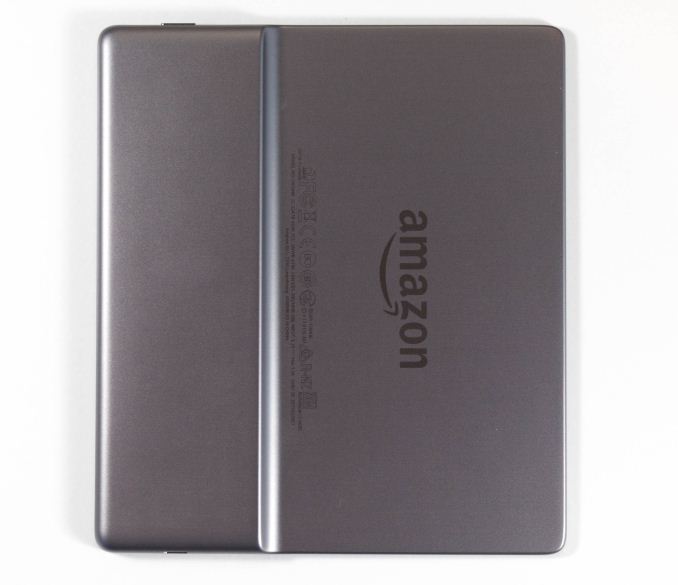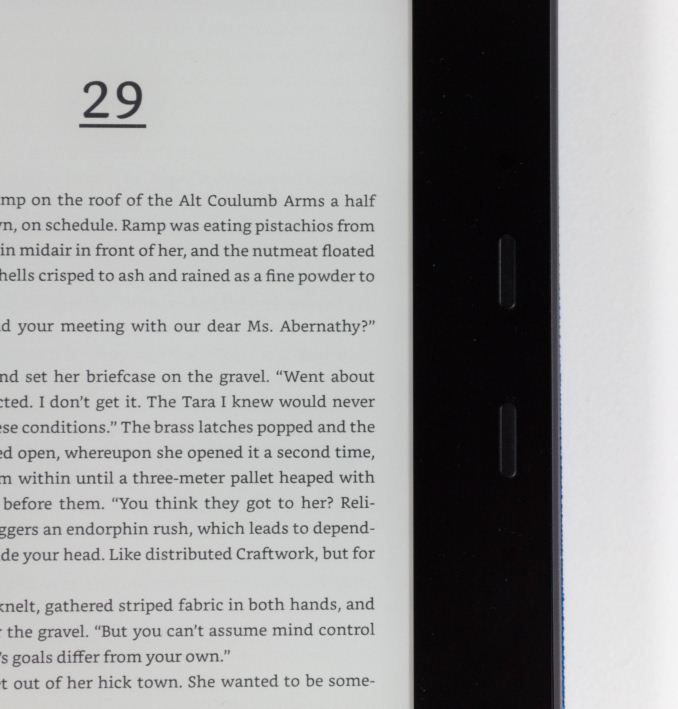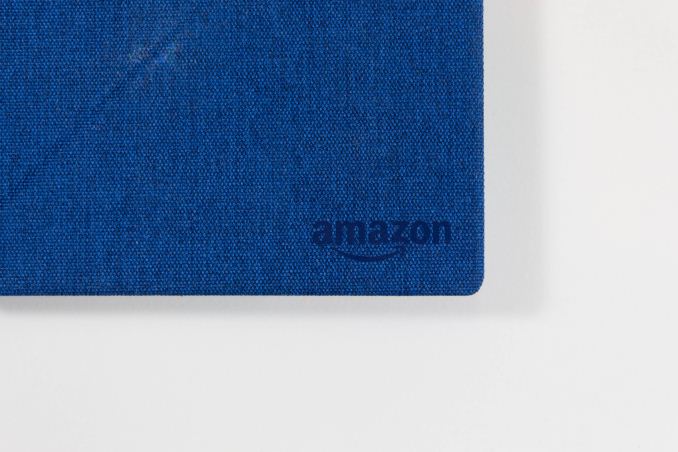The Amazon Kindle Oasis (2017) Review: A Premium Take On The E-Reader
by Brett Howse on January 25, 2018 8:00 AM EST- Posted in
- Accessories
- Amazon
- Kindle
- e-ink
- E-Reader
- Kindle Oasis
Design
Amazon has taken an unorthodox approach to the design of the Kindle Oasis for 2017. It’s asymmetrical, with thin bezels on three sides, and a much larger bezel on one side. That same side has a bulge on the back, which houses most of the circuitry and battery storage.
The asymmetrical design shifts the center of gravity of the device to one side, which makes it easier to hold in one hand, since the device will have less leverage on your muscles. It’s a pretty smart design, and in use it does work well. It lets the device taper to just 3.4 mm thick, and the whole thing weighs only 194 grams, which is 10 grams less than a Paperwhite. 10 grams doesn’t sound like much, but with the larger display, the Kindle Oasis certainly feels lighter.
The side also has physical page turn buttons, which is not something that’s always available anymore on Kindles. Most of the devices just offer a touchscreen to turn pages, but that can mean moving your thumb over for every page. That still works on the Kindle Oasis, but the two buttons can be used which allows you to keep your hand in one place. The buttons are setup so that the top turns forward, and the bottom turns backwards, but you can switch that in the settings if you’d prefer it the other way around.
The Kindle Oasis also has an accelerometer which will automatically rotate the page 180° if you flip the book over, and the page buttons also swap around, so the top button stays as page forward.
The aluminum shell offers the same premium material feel of a high-end smartphone, and it is much more resistant to fingerprints than the soft-touch plastic of the Paperwhite. But the device is a bit too smooth in the hand, and more texture on the surface would be appreciated to make it less slippery.
With the asymmetrical design, and the aluminum exterior, the Kindle Oasis stands out compared to other E-Reader devices on the market. This, coupled with the light weight, make for a nice feel when holding the Oasis for long periods.
Accessories
With any Kindle launch, Amazon also creates some custom covers and cases for the Kindles, and the Oasis is no exception. For this round, thanks to the design of the new Oasis, the official covers fit in a unique way in that they fill in the gap on the back, and then have a cover that swings around the front. The cases are held on with magnets, and it includes a magnet on the top cover which will lock the cover on the front to keep it closed, as well as hold the cover open when it’s swung around to the back. It also has the benefit of being a wakeup signal to the Oasis to power it up when you open the cover.
The covers also have a flexible portion to allow you to use the cover as a stand. I’m not sure how useful this is, but if you want to prop it up, it’s an option.
Amazon sent both the leather cover, and the fabric cover. The fabric one gives a great texture to the device, and provides a lot more grip, and as such it’s my preference. It’s also splash resistant, so if you get water on it, it will bead off. The leather one is a soft leather, but a bit more slippery.
On most Kindles, I don’t run a cover anymore, due to the extra weight. The Oasis is a bit of an exception though, and the cover to fill in the gap and add a bit more texture to the device has been a welcome addition during some reading sessions. It does add about 100 grams to the total weight, which doesn’t sound like a lot, but it’s half the weight of the Oasis itself, so even Amazon recommends removing the case when reading.
But, even though the cases that arrived with the review unit have worked very well, the reviews on Amazon for the first-party cases that first shipped with the new Oasis are very negative . It appears there’s issues with consistency of the strength of the magnets, and many customers are complaining about the cases not staying on. Amazon has clearly taken this to heart, and the current batch are no longer available from them. We’re told new versions will be available in the coming weeks. Luckily, there’s no shortage of 3rd party cases, and most of them seem to have better reviews.














93 Comments
View All Comments
vanilla_gorilla - Thursday, January 25, 2018 - link
That cost difference is completely negligible considering how much time I spend reading on a kindle. I went from a paperwhite to an oasis and it's been great. You can disable the infernal touch screen so that only the three physical buttons work (page forward, back and power to lock and re-enable the touch screen). I can't tell you how many times my finger accidentally made it a millimeter onto the touchscreen on my paperwhite and caused a page turn. Then as I poked at it angrily to flip back, I turn another page the wrong direction.Anyway, I couldn't be happier, display is beautiful and the device feels great and has tons of great features my paperwhite didn't have, but I would have paid the difference just on the quality of the device, display and tactile buttons.
Scrote - Thursday, January 25, 2018 - link
Typo here:"The 2017 Oasis adds some nice features over it’s lower brethren though."
over it is lower brethren? :)
prateekprakash - Thursday, January 25, 2018 - link
Is it possible to read PDF created by us on the display?In that case Kindle would be useful to me that I would be able to read my notes.
DanNeely - Thursday, January 25, 2018 - link
My 6 year old Kindle can read PDFs so I'd assume new ones can too.The main limiting factor in doing so though is that it can't reflow them to fit better on the small screen. Unless newer models can do that reading PDFs designed for a standard letter/a4 page will have uncomfortably small text in many cases unless you want to be scrolling left/right to read each line of text.
mode_13h - Friday, January 26, 2018 - link
For PDFs, check out the Kobo Aura ONE, with a 1872x1404 7.8" screen, using the same 300 dpi e-ink technology as this Kindle. That's almost the same vertical resolution as you get on a 4k monitor.Brett Howse - Friday, January 26, 2018 - link
Assuming you don't have a lot of graphics in your PDF, the best way to do this is to use the Amazon service to send it to your Kindle, and their service will OCR it and convert it into an e-book so the text can reflow.KLC - Thursday, January 25, 2018 - link
I read reviews like this and comments like the ones just made and wonder why the ereader experience hasn't grabbed me. I read a lot, multiple books a week. I once tried a kindle and I agree that reading on an LCD device like a phone or iPad doesn't compare to e ink. It really is just like reading print. I want to use a kindle, to have multiple books on one small but good device. So why don't I? It's the ebooks, I find almost all of them to be terrible, poorly designed, poorly executed, ridden with errors, lacking what is available in printed editions. I love kindles but I hate ebooks.DanNeely - Thursday, January 25, 2018 - link
What're you using as your ebook source, and what are you trying to read? With the exception of some really old files (I've got some decade+ old files from when a publisher was giving away free samples for promotional purposes) I haven't had formatting/quality problems with any new release commercial fiction ebooks I've bought from a major publisher.Stuff I've gotten from the Gutenberg Project's been a lot more hit and miss. Raw scans or ones that appear to've only had someone go through and fix the worst of the scanning errors are going to be awful.
The only category I still generally prefer print for is non-fiction with maps/charts/etc because there's no kindle equivalent to a half dozen bookmarks stuffed in various locations so I can quickly flip to the non-text information as needed and then back to where I'm reading.
KLC - Thursday, January 25, 2018 - link
I agree that current fiction titles are fine, I should have added that much of what I read is non-fiction with charts, graphs and especially endnotes. Many ebooks seem to be done as unthinking, poorly planned replications of text, as if 99% of the work went in to the book and then they told an intern to take the afternoon and port it to an ebook to capture some extra dollars. There seems to be little focus on ebooks as a unique product that take advantage of electronic text.And what you say about Gutenberg kind of illustrates what I would love to have a Kindle for and why I find ebooks so lacking. I'd love to have a library of classic literature, the books I want to read someday but never get around to. But I've been constantly disappointed with the quality of those kind of books. I'm willing to pay but I find that many of the paid versions as lacking as the free versions. You type in a title in Amazon, say Don Quixote, and you get dozens of versions, some paid, some free. How do you successfully weed out the poor ones without making it a day's work of downloading and sampling each one? I'd love to have a source of classic lit ebooks that has consistent quality of design and execution.
robinwhittleton - Thursday, January 25, 2018 - link
I contribute to the Standard Ebooks project and that does everything you’re asking for: takes Gutenberg sources and makes high quality ebooks from them.